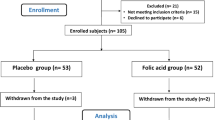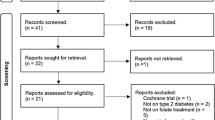Abstract
Objective: To investigate whether vitamin B6 supplementation had a beneficial effect on lowering fasting plasma homocysteine concentrations in coronary artery disease (CAD) patients.
Design: A single-blind intervention study.
Setting: The study was performed at the Taichung Veterans General Hospital, the central part of Taiwan.
Subjects: A total of 50 subjects were identified by cardiac catheterization to have at least 70% stenosis of one major coronary artery. In all, 42 patients successfully completed this study.
Interventions: Patients were randomly assigned to one of five groups and treated with a daily dose of placebo (n=8), 5 mg vitamin B6 (n=8), 10 mg vitamin B6 (n=8), 50 mg vitamin B6 (n=9), or 5 mg folic acid combined with 0.25 mg vitamin B12 (n=9) for 12 weeks.
Main outcome measures: Nutrient intakes were recorded by using 24-h diet recalls when patients returned to the cardiology clinic before the intervention (week 0) and at week 12. Vitamin B6 status was assessed by direct measures (plasma pyridoxal 5′-phosphate) and indirect measures (erythrocyte alanine and aspartate aminotransaminase activity coefficient). Fasting plasma homocysteine, serum folic acid, and vitamin B12 were measured.
Results: Fasting plasma homocysteine concentration did not respond to high or low doses of vitamin B6 when compared with a placebo treatment after 12 weeks of supplementation. The mean fasting plasma homocysteine concentration, however, decreased significantly after 12 weeks of folic acid combined with vitamin B12 supplementation (P=0.047). Further, within group, mean fasting plasma homocysteine concentration was nonsignificantly increased by 25.5, 16.2, and 18.3% in placebo, 10 mg/day and 50 mg/day vitamin B6 supplemented groups, respectively; whereas folic acid combined with vitamin B12 supplementation significantly reduced fasting plasma homocysteine concentration by 32% (P<0.001).
Conclusions: Our results indicate that vitamin B6 supplementation alone is less effective than folic acid combined with vitamin B12 in lowering plasma homocysteine concentrations in CAD patients.
Sponsorship: This study was supported by the National Science Council, Taiwan, Republic of China (NSC-91-2320-B-040-023).
This is a preview of subscription content, access via your institution
Access options
Subscribe to this journal
Receive 12 print issues and online access
$259.00 per year
only $21.58 per issue
Buy this article
- Purchase on Springer Link
- Instant access to full article PDF
Prices may be subject to local taxes which are calculated during checkout
Similar content being viewed by others
References
Araki A & Sako Y (1987): Determination of free and total homocysteine in human plasma by high-performance liquid chromatography with fluorescence detection. J. Chromatogr. 422, 43–52.
Arnadottir M, Brattstrom L, Simonsen O, Thysell B, Hultberg B, Andersson A & Nilsson-Ehle P (1993): The effect of high-dose pyridoxine and folic acid supplementation on serum lipid and fasting plasma homocysteine concentrations in dialysis patients. Clin. Nephrol. 40, 236–240.
Bailey LB, Duhaney RL, Maneval DR, Kauwell GP, Quinlivan EP, Davis SR, Cuadras A, Hutson AD & Gregory III JF (2002): Vitamin B12 status is inversely associated with plasma homocysteine in young women with C677T and/or A1298C methylenetetrahydrofolate reductase polymorphisms. J. Nutr. 132, 1872–1878.
Bates CJ, Pentieva KD, Matthews N & Macdonald A (1999): A simple, sensitive and reproducible assay for pyridoxal 5′-phosphate and 4-pyridoxic acid in human plasma. Chin. Chim. Acta 280, 101–111.
Bautista LE, Arenas IA, Penuela A & Martinez LX (2002): Total plasma homocysteine level and risk of cardiovascular disease: a meta-analysis of prospective cohort studies. J. Clin. Epidemiol. 55, 882–887.
Bosy-Westphal A, Holzapfel A, Czech N & Muller MJ (2001): Plasma folate but not vitamin B12 or homocysteine concentrations are reduced after short-term vitamin B6 supplementation. Ann. Nutr. Metab. 45, 255–258.
Boushey CJ, Beresford SA, Omenn GS & Motulsky AG (1995): A quantitative assessment of fasting plasma homocysteine as a risk factor for vascular disease. Probable benefits of increasing folic acid intakes. JAMA 274, 1049–1057.
Brattström L, Israelsson B, Norrving B, Bergqvist D, Thorne J, Hultberg B & Hamfelt A (1990): Impaired homocysteine metabolism in early-onset cerebral and peripheral occlusive arterial disease. Effects of pyridoxine and folic acid treatment. Atherosclerosis 81, 51–60.
Brouwer IA, van Dusseldorp M, Thomas CM, Duran M, Hautvast JG, Eskes TK & Steegers-Theunissen RP (1999): Low-dose folic acid supplementation decreases fasting plasma homocysteine concentrations: a randomized trial. Am. J. Clin. Nutr. 69, 99–104.
Chan SJ, Chang CN, Hsu JC, Lee YS & Shen CH (2002): Homocysteine, vitamin B6, and lipid in cardiovascular disease. Nutrition 18, 595–598.
Chasan-Taber L, Selhub J, Rosenberg IH, Malinow MR, Terry P, Tishler PV, Willett W, Hennekens CH & Stampfer MJ (1996): A prospective study of folate and vitamin B6 and risk of myocardial infarction in US physicians. J. Am. Coll. Nutr. 15, 136–143.
Clarke R & Armitage J (2000): Vitamin supplements and cardiovascular risk: review of the randomized trials of homocysteine-lowering vitamin supplements. Semin. Thromb. Hemost. 26, 341–348.
Dudman NP, Wilcken DE, Wang J, Lynch JF, Macey D & Lundberg P (1993): Disordered methionine/homocysteine metabolism in premature vascular disease. Its occurrence, cofactor therapy, and enzymology. Arterioscler. Thromb. 13, 1253–1260.
Food and Nutrition Board—Institute of Medicine (1998): Dietary Reference Intakes. Thiamin, Riboflavin, Niacin, Vitamin B-6, Folate, Vitamin B-12, Pantothenic acid, Biotin, and Choline. Washington, DC: National Academy Press.
Ford ES, Smith SJ, Stroup DF, Steinberg KK, Mueller PW & Thacker SB (2002): Homocyst(e)ine and cardiovascular disease: a systematic review of the evidence with special emphasis on case–control studies and nested case–control studies. Int. J. Epidemiol. 31, 59–70.
Genest Jr JJ, McNamara JR, Salem DN, Wilson PW, Schaefer EJ & Malinow MR (1990): Plasma homocyst(e)ine levels in men with premature coronary artery disease. J. Am. Coll. Cardiol. 16, 1114–1119.
Lee BJ, Lin PT, Liaw YP, Chang SJ, Cheng CH, Huang YC (2003): Homocysteine and risk of coronary artery disease: folate is the important determinant of fasting plasma homocysteine concentration. Nutrition 19, 577–583.
Lindenbaum J, Savage DG, Stabler SP & Allen RH (1990): Diagnosis of cobalamin deficiency: II. relative sensitivities of serum cobalamin, methylmalonic acid, and total homocysteine concentrations. Am. J. Hematol. 34, 99–107.
Mansoor MA, Kristensen O, Hervig T, Bates CJ, Pentieva K, Vefring H, Osland A, Berge T, Drablos PA, Hetland O & Rolfsen S (1999): Plasma total homocysteine response to oral doses of folic acid and pyridoxine hydrochloride (vitamin B6) in healthy individuals. Oral doses of vitamin B6 reduce concentrations of serum folate. Scand. J. Clin. Lab. Invest. 59, 139–146.
McKinley MC, McNulty H, McPartlin J, Strain JJ, Pentieva K, Ward M, Weir DG & Scott JM (2001): Low-dose vitamin B-6 effectively lowers fasting plasma homocysteine in healthy elderly persons who are folate and riboflavin replete.Am. J. Clin. Nutr. 73, 759–764.
Miller JW, Ribaya-Mercado JD, Russell RM, Shepard DC, Morrow FD, Cochary EF, Sadowski JA, Gershoff SN & Selhub J (1992): Effect of vitamin B-6 deficiency on fasting plasma homocysteine concentrations. Am. J. Clin. Nutr. 55, 1154–1160.
Morrison HI, Schaubel D, Desmeules M & Wigle DT (1996): Serum folate and risk of fatal coronary heart disease. JAMA 275, 1893–1896.
Robinson K, Mayer EL, Miller DP, Green R, van Lente F, Gupta A, Kottke-Marchant K, Savon SR, Selhub J & Nissen SE (1995): Hyperhomocysteinemia and low pyridoxal phosphate. Common and independent reversible risk factors for coronary artery disease. Circulation 92, 2825–2830.
Rydlewicz A, Simpson JA, Taylor RJ, Bond CM & Golden MHN (2002): The effect of folic acid supplementation on fasting plasma homocysteine in an elderly population. Q. J. Med. 95, 27–35.
Selhub J & Miller JW (1992): The pathogenesis of homocysteinemia: interruption of the coordinate regulation by S-adenosylmethionine of the remethylation and transsulfuration of homocysteine. Am. J. Clin. Nutr. 55, 131–138.
Serfontein WJ, Ubbink JB, de Villiers LS, Rapley CH & Becker PJ (1985): Plasma pyridoxal-5-phosphate level as risk index for coronary artery disease. Atherosclerosis 55, 357–361.
Stampfer MJ, Malinow MR, Willett WC, Newcomer LM, Upson B, Ullmann D, Tishler PV & Hennekens CH (1992): A prospective study of plasma homocyst(e)ine and risk of myocardial infarction in US physicians. JAMA 268, 877–881.
Ubbink JB, Vermaak WJH, van der Merwe A, Becker PJ, Delport R & Potgieter HC (1994): Vitamin requirements for the treatment of hyperhomocysteinemia in humans. J. Nutr. 124, 1927–1933.
Ubbink JB, van der Merwe A, Delport R, Allen RH, Stabler SP, Riezler R & Vermaak WJ (1996): The effect of a subnormal vitamin B-6 status on homocysteine metabolism. J. Clin. Invest. 98, 177–184.
Verhoef P, Stampfer MJ, Buring JE, Gaziano JM, Allen RH, Stabler SP, Reynolds RD, Kok FJ, Hennekens CH & Willett WC (1996): Homocysteine metabolism and risk of myocardial infarction: relation with vitamin B-6, B-12, and folate. Am J. Epidemiol. 143, 845–859.
Woodring MJ & Storvick CA (1970): Effect of pyridoxine supplementation on glutamic–pyruvic transaminase, and in vitro stimulation in erythrocytes of normal women. Am. J. Clin. Nutr. 23, 1385–1395.
Author information
Authors and Affiliations
Contributions
Guarantor: YC Huang.
Contributors: B-JL was responsible for the screening and intervention of subjects and interpretation of the results. M-CH was responsible for the interpretation of the results and critical revisions of the manuscript. L-JC was responsible for nutrient data coding and sample analyses. C-HC was responsible for the screening of subjects. K-LL was responsible for the hematological measurements. K-Hs was responsible for the critical revisions in the manuscript. Y-CH was responsible for the development of intellectual content and the study design, interpretation of the results and manuscript drafting.
Corresponding author
Rights and permissions
About this article
Cite this article
Lee, BJ., Huang, MC., Chung, LJ. et al. Folic acid and vitamin B12 are more effective than vitamin B6 in lowering fasting plasma homocysteine concentration in patients with coronary artery disease. Eur J Clin Nutr 58, 481–487 (2004). https://doi.org/10.1038/sj.ejcn.1601834
Received:
Revised:
Accepted:
Published:
Issue Date:
DOI: https://doi.org/10.1038/sj.ejcn.1601834
Keywords
This article is cited by
-
Effects of an L-arginine-based multi ingredient product on endothelial function in subjects with mild to moderate hypertension and hyperhomocysteinemia - a randomized, double-blind, placebo-controlled, cross-over trial
BMC Complementary and Alternative Medicine (2017)
-
Hyperhomocysteinemia impairs regional blood flow: involvements of endothelial and neuronal nitric oxide
Pflügers Archiv - European Journal of Physiology (2016)
-
The biomarker-based validity of a food frequency questionnaire to assess the intake status of folate, pyridoxine and cobalamin among Iranian primary breast cancer patients
European Journal of Clinical Nutrition (2014)
-
Changes in predictors and status of homocysteine in young male adults after a dietary intervention with vegetables, fruits and bread
European Journal of Nutrition (2008)
-
B-vitamins, homocysteine and gene polymorphism in adults with fasting or post-methionine loading hyperhomocysteinemia
European Journal of Nutrition (2008)



